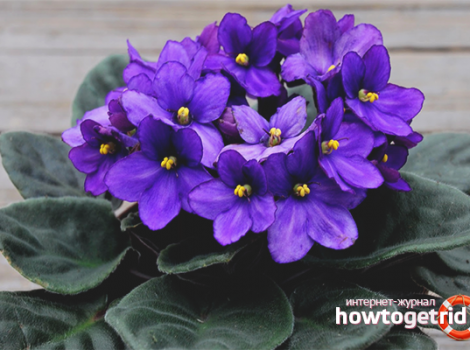Content
- 1 Flower "Mother-in-law tongue" - description
- 2 Varieties and types of flower
- 3 Growing features
- 4 Home care
- 5 Disease and pest control
- 6 How to grow?
- 7 Photo
- 8 Reproduction
- 9 Finally
- 10 Useful video
- 11 Plant Care Memo
- 12 Lighting
- 13 Temperature
- 14 Watering
- 15 The soil
- 16 Fertilizer
- 17 Humidity
- 18 Trim / Support / Garter
- 19 Diseases
- 20 Problems
- 21 Reproduction
- 22 Transfer
- 23 Useful Tips
- 24 Plant toxicity and care and placement precautions
- 25 Description of the plant and species
One of the most unpretentious plants is the Mother-in-law's tongue flower. It is suitable for decorating the interior of even the laziest housewife, as it does not require daily care and watering. However, there are still some features in growing, and you should familiarize yourself with them before purchasing a plant.
Flower "Mother-in-law tongue" - description
Initially, this flower is called sansevieria, but it also has many other designations. Among them, the most memorable are "Pike Tail", "Snake Skin", "Indian Sword". Some call this flower - "Devil's Tongue".

The appearance of these names is directly related to the appearance of the plant. It consists of wide, dense leaves growing directly from the ground, which have an uneven green color. The shape of each leaf really resembles a huge tongue.
The plant looks pretty pretty and will suit those housewives who like to see greenery on the windowsill. Although some varieties of sansevieria, with proper care, can bloom and even bear fruit.
Varieties and types of flower
All types of mother-in-law have similar parameters. The flower is large leaves sticking out of the soil, which differ in color, depending on the variety. In rare cases, the plant blooms with small white flowers. However, this is not particularly attractive. All beauty is concentrated in the colors of the foliage.
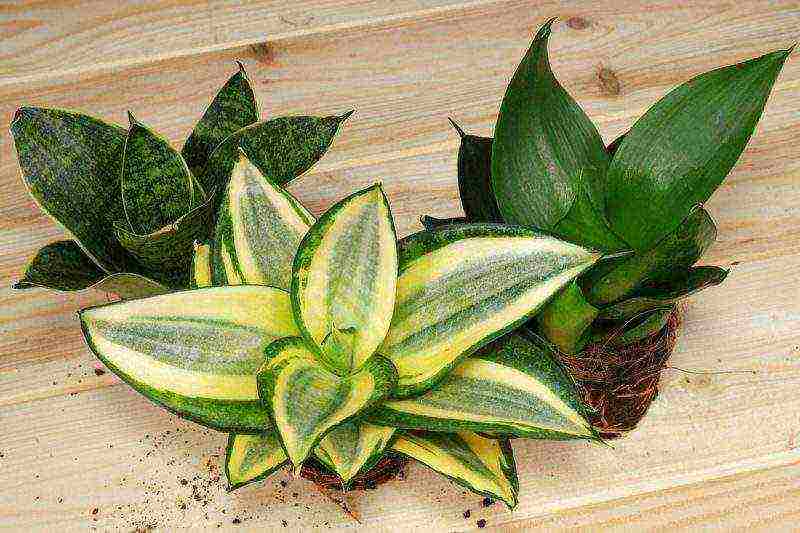
The most popular types of pike tail:
- Three-lane. It is an average width of dark green leaves, on the sides of which there are dark yellow stripes of the same thickness.
- Liberian. The sheets have a dense structure, very wide, slightly curled with each other near the ground. At the top, the plant unfolds mainly with six flat leaves. Plants are dark green in color, there are light green strokes around the perimeter.
- Pick. This variety is a rosette with several thin dark green leaves. The plant has a white speck along the entire perimeter and a thin brown edging.
- Graceful. A succulent plant is represented by one dry stem, protruding from the soil by about 5 cm. Then dense gray-green leaves begin, which resemble beans or a thin snake in shape. There are also light streaks on each sheet.
- Duneri. The variety looks like a green flower. The rosette is small, formed by 15-20 thin pointed leaves. This type of plant reaches a height of no more than 40 cm. Looks beautiful in combination with stones.
There are many more varieties of sansevieria, many of which reach more than half a meter in size. Almost all varieties are suitable for keeping at home, as they do not depend on temperature or humidity.
Growing features
Sansevieria is a succulent, so you need to try hard to get the plant sick or wilted. However, this is still possible.Most often, Mother-in-law's tongue dies from root rot or disease.

Care requirements are limited to a few points:
- the flower should not be watered often - this will quickly ruin the plant;
- a window sill becomes an ideal place for growing, but it is better to choose a place without direct sunlight;
- fertilization is also necessary, but it is sufficient to do this once a year.
Sansevieria tolerates any temperature well, does not suffer from land drought. But from the overflow of the soil, it can die instantly.
Periodically, it is recommended to wipe the pike tail with a damp sponge to get rid of dust. Then the flower will have a beautiful appearance with bright green leaves.
Home care
Mother-in-law's flower care is limited to occasional watering and fertilization as needed. Sometimes the plant will need to be transplanted, but it is recommended to carry out such an action no more than once every 2-3 years.
Requirements for soil and pot
As the plant grows, it hardens in the rhizome, which can break the plastic pot. To prevent this from happening, it is better to choose a clay bowl with thick walls. This is also necessary for the stability of the Mother-in-law tongue. Large heavy leaves can turn over in a light pot, the flower will break and die.
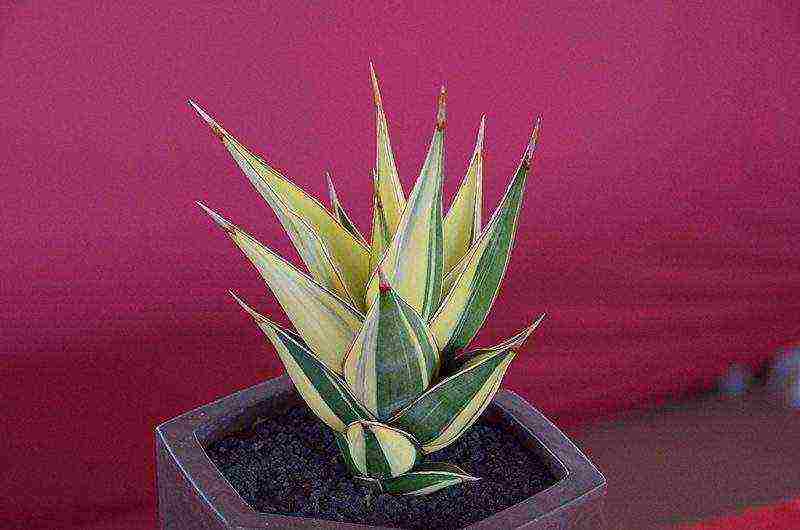
Garden or forest soil for sansevieria will not work. It is recommended to purchase an earthen mixture in a specialized store, since it will contain the most optimal content of all constituent ingredients. The soil composition is formed by sod and leafy soil, sand, and fine gravel.
Optimal conditions of detention
The pike tail does not require any serious conditions of detention, but in order for the flower to have the most attractive appearance, it is recommended to monitor the temperature in the room. It should not drop below 16 degrees. The plant tolerates high temperatures better than low temperatures. You should not place the pot near an open window during the winter season.

If the hostess wants to achieve a bright pattern on the leaves, it is better to keep the sansevieria in a place with a lot of sunlight. In constant darkness, the leaves acquire a faded shade, they can turn yellow. To achieve flowering pike tail, it is better to plant it in tighter pots.
Watering a flower
The appearance of the plant directly depends on the amount of liquid in the soil. Watering is necessary without experimentation. It is recommended to monitor the soil moisture and enrich it with water only after complete drying. In the summer, the succulent should be watered no more than once a week, and in the winter once every 2-3 weeks.

Tap water has a detrimental effect on the flower, so for watering, you should take distilled or settled liquid. Rainwater without impurities will work well.
How to transplant correctly?
The cultivation of sansevieria involves its periodic transplantation. This is required due to the growth of the root system, as well as the gradual depletion of the soil from all nutrients.
To transplant a color, you should carefully remove it from the pot, remove all excess soil from the rhizome. Then transplant it into another dish of a suitable size, at the bottom of which there are already small stones and some of the new soil. Plant the plant in a pot, slightly crushing the roots, cover it with earth without reaching a couple of centimeters to the base.
For decoration, you can put medium-sized stones on top, about 1-3 cm wide. The gray shade contrasts beautifully with the dark green, emphasizing the nobility of the deep color of the leaves.
Disease and pest control
Like any other houseplant, sansevieria can get sick. Most problems are solvable if action is taken quickly.

The most common diseases of the pike tail:
- The formation of light spots on foliage. It is the result of direct sunlight on the flower. To avoid excessive drying, it is better to put the pot in a place with diffused light.
- Rotting leaves. Occurs due to the overflow of the flower.A radical measure to save sansevieria is transplantation into drier soil. In the future, it is recommended to carefully monitor soil moisture. To make this easier, you can purchase a special meter.
- Loss of color up to whitish color. Characterizes the appearance of a spider mite. To get rid of ill-wishers, you should wipe the mother-in-law's tongue with a damp cloth, and also sprinkle the surface with an insecticide.
- The appearance of gray-brown spots on the leaf. Indicate damage by thrips - small insects that are located on the inside of the leaves. To get rid of the pest, it is recommended to remove the inflorescences, if any. Spraying the plant must be carried out three times at weekly intervals. It is necessary to process not only the flower, but also the soil.
- Curved leaves of a yellowed color. They may indicate the settlement of a mealy worm that loves to live at the base of the pike's tail. The insect must be removed by hand, then treated with Malathion.
With proper, but not complicated care, the plant lives for a long time and decorates the interior with the greenery of its foliage. That is why sansevieria is becoming a favorite with most housewives.
The flower "mother-in-law's tongue" is a worthy candidate from which to start floriculture. It has high decorative qualities, is unpretentious, purifies the air and produces a lot of oxygen. But this does not mean that the plant does not need to be cared for at all. Moderate light, watering and feeding will allow you to grow a beautiful and healthy flower.

Plant characteristic
"Mother-in-law's tongue" is one of the names of the sansevier plant from the agave family. In nature, it lives in the subtropical regions of Africa, Asia, America, and is found in the savannas. The flower "mother-in-law's tongue" is also common in household use. Its beautiful leaves, collected in a rosette, can be flat and long, oval and thick, wide, xiphoid, rounded, in the form of a spoon or a pencil. More often the leaves are oriented upward, but there are species that bloom in different directions or grow parallel to the ground. Sansevier leaves usually have a tip on the tips, but if it is broken off, growth will deteriorate.
Varieties
In total, there are about 200 varieties of the flower "mother-in-law's tongue". The most common type is the three-lane sansevier with flat oval leaves. They have a characteristic pattern - a light green stripe on a dark green background.

In the flower shop, you can also find other varieties of sansevier, for example, Sansevieria trifasciata Laurentii with green and yellow stripes.

Or Sansevieria Zeylanica, whose leaves are colored with a variegated dark green.

If you prefer plants with short leaves, check out Sansevieria trifasciata Laurentii Compacta.
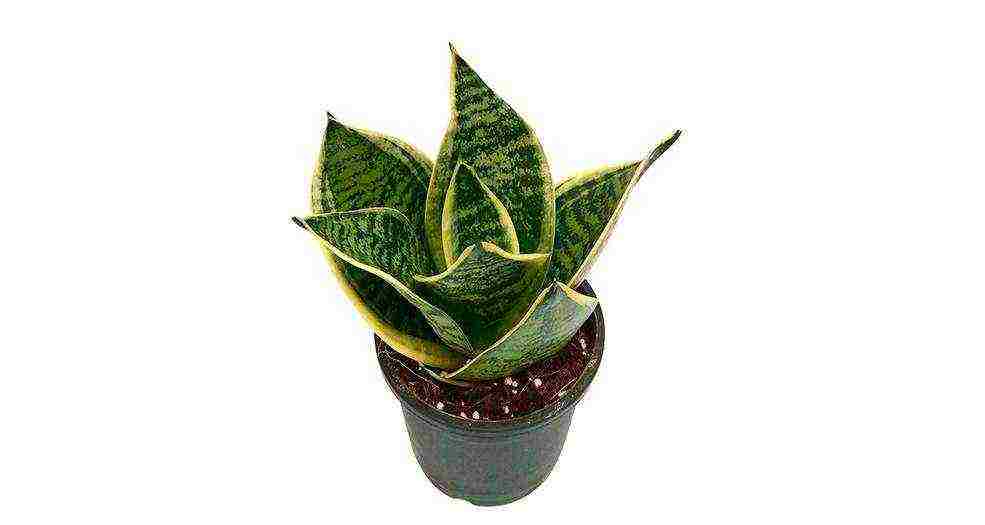
Lovers of exotic colors will appreciate Sansevieria trifasciata Hahnii with silver stripes.
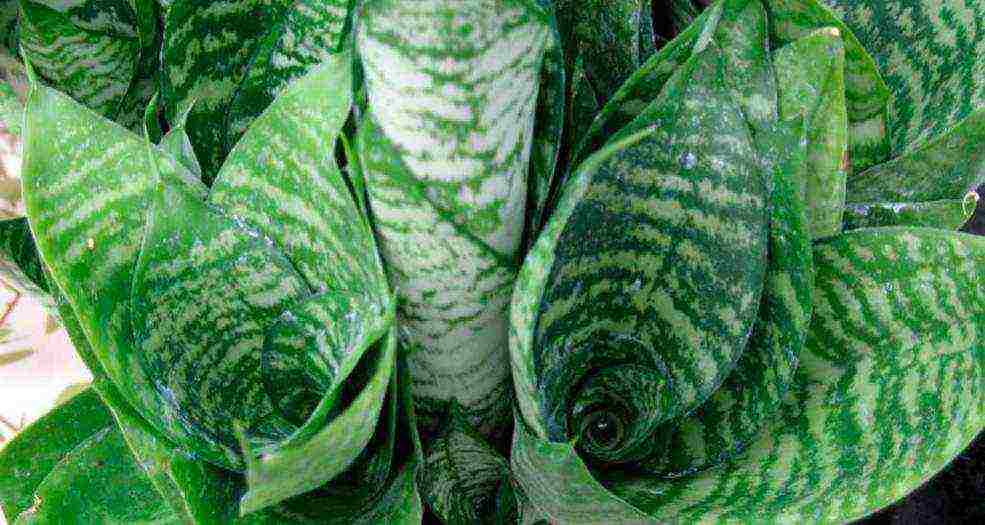
In the case when a very tall plant is required, you can purchase the species Sansevieria robusta, the length of which reaches 180 cm. Its leaves are green, pointed, growing straight up.
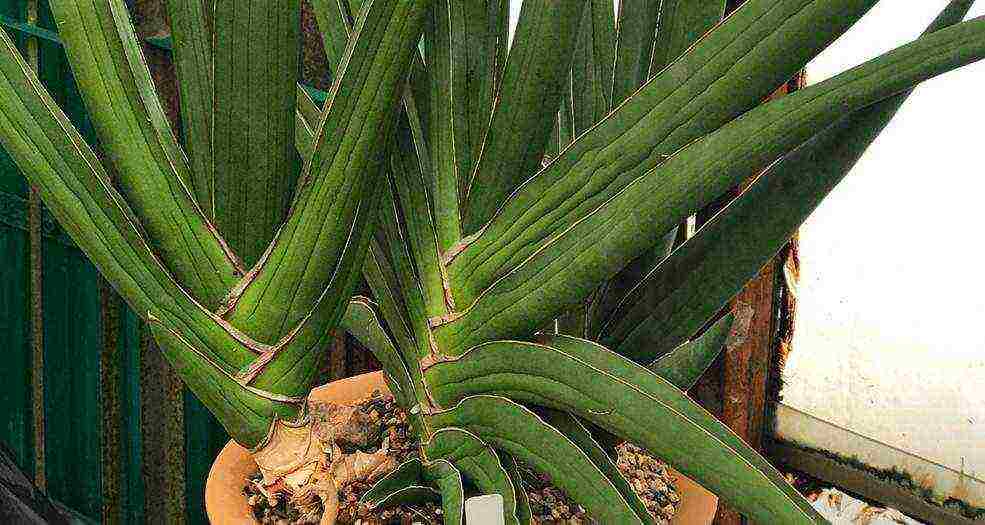
Lighting
The flower "mother-in-law's tongue" comes from hot regions, and at home it also needs the sun. The plant thrives in excess light, but in summer it needs shading on southern windows.
The amount of light that variegated varieties require is determined by the natural coloration of the leaf. If the proportion of yellow is large, less light is required, otherwise the leaf will lose its variegation and become the usual green. But if there is too little light, the flower will slow down in development. In any case, the sansevier must be protected from direct rays, otherwise the colored areas will get sunburn. The ideal place is a window sill, into which the light enters in the evening.
Temperature
The plant does not require strict temperature conditions. It feels comfortable at night at +16 ... +20 ° С and during the day at +21 ... +28 ° С.It will also withstand a greater range of temperatures, but in this case, the microclimate must be leveled by irrigation. If the flower lives in the cold, for example, in an office building, then it is important to reduce the frequency of watering.
Watering
Sansevier does not like spraying, it does not tolerate it when water gets inside the outlet, and from this it can even rot. But on the other hand, the plant survives drought well.
The flower "mother-in-law's tongue" is watered sparingly and only after the soil dries out. He feels great without water for a while. As mentioned above, at low temperatures, water the plant less often, the same applies to sanseviers placed in the shade.
Dust the plant from time to time. Use a rag or special duster.
Top dressing
The need for fertilizer is determined by the season. During the wintering period, feeding should be abandoned. From May to September, the flower "mother-in-law's tongue" needs to be fertilized every two weeks, using top dressing for cacti and succulents, or mineral compositions. If the variety is variegated, make sure that the fertilizer does not contain a lot of nitrogen: this provokes increased production of chlorophyll, and the multi-colored handsome man will become ordinary green. In other periods, fertilize once a month.
Transfer
The need for a transplant depends on the growth rate of the flower. In young plants, it is higher, and they need to change the pot annually for dishes with a diameter of 2 cm larger. Mature plants can live in one pot for several years.
When transplanting, choose shallow containers. Sansevier does not need a large amount of soil, its roots are located on the surface.
A young flower "mother-in-law's tongue" should be transplanted every year, an adult - every few years.
When choosing a soil, give preference to a poorly nutritious, light one and one that dries out faster. Ideally, this should be a specialized mix for cactus and succulent plants. But you can mix equal parts of leafy soil, turf soil, and sand to create a suitable substrate. Before planting the plant, the soil mixed by yourself is best calcined.
Reproduction
Sansevier can be propagated by lateral layering, by dividing the rhizome or by leaf cuttings.
Lateral shoots are developed mainly in low-growing rosette plants. It is better to plant them in the spring when transplanting the mother plant. To do this, carefully cut off the process with a sharp knife, grabbing part of the rhizome. Places of separation on the mother and young bush should be sprinkled with a powder made from activated carbon. After that, it is enough to place the plants in separate pots. In order for the sansevier to take root faster, it is better to keep it warm with moderate watering.
Rhizome division is the most preferred type of reproduction of the mother-in-law's tongue flower. With this method, all the specific characteristics of the plant are preserved. The rhizome is separated in early spring from an adult plant. Take the sansevier out of the pot, disinfect the knife, divide the root into 3-4 parts depending on the size. Each section should have its own growth point. Treat all cuts with crushed coal, then plant the plants in a sandy substrate. Rooting takes place with moderate watering. If you have done everything correctly, the plant will have new shoots, and when this happens, you can transplant the young bushes into a new pot.
Tall species of uniform color sansevier are propagated by leaf cuttings. Specific features, however, are not preserved - the plants will be monochromatic and without stripes. Take an old strong leaf, disinfect a knife or pruner, cut the workpiece into several pieces 4–5 cm long and spread them in the direction of the leaf's growth, so as not to forget where the top and bottom are. Cuttings should be dried in air for 24 hours or treated with crushed activated carbon. Then plant the segments with the bottom part in wet sand about a third of the length.For the cuttings to root better, they need to be covered with a glass jar, pour water into the pan and put in a warm place. Rooting will take 1–1.5 months.
Diseases
The flower "mother-in-law's tongue" rarely gets sick, but in case of gross violations of the rules of care, it can acquire defects.
- With waterlogging and low temperatures, dark spots appear on the leaves.
- With a lack of light or in a too cramped pot, the leaves turn yellow.
- Insufficient lighting also leads to the fact that the plant weakens, its leaves become soft, stretch and deviate vertically, or bend in half.
- When water enters the center of the outlet, the plant rots at the base, the leaves become soft and turn yellow.
- When freezing, over-watering, or lack of light, the tips of the leaves of the sansevier can fade, turn yellow and dry.
- If the plant is not watered for too long, the leaves lose their elasticity.
Basically, defects are corrected by competent care.
In all other respects, the plant is quite unpretentious and survives where others give up. With proper care, the flower will retain its attractive colors and austere shape.
How to grow?
Growing a pike tail does not require any special knowledge and skills. The plant is pretty easy endures adverse conditions, quickly enough adapts to them:
- tolerates scanty and irregular watering;
- withstands temperature drops;
- does not die in low light.
The only thing is that bad conditions can affect the condition leaves sansevieria: they will remain dark green, but the drawing may fade significantly.
 The main concerns for growing this flower are in the post-breeding period. In the beginning, young plants should be grown in small-sized pots - this will help them to settle down better, gain strength and start growing.
The main concerns for growing this flower are in the post-breeding period. In the beginning, young plants should be grown in small-sized pots - this will help them to settle down better, gain strength and start growing.
Transplantation of sansevieria is carried out every 2-3 years, when the pot already becomes too small for a matured and overgrown flower.
Mother-in-law's tongue does not require frequent watering - they should be moderate and performed only when the surface of the soil in the pot becomes completely dry. Excess moisture should not be allowed - the flower will react to this by dropping the leaves (which will turn yellow before that).
It is recommended to water the pike tail in the cold season only once a month. Do not allow water to fall into the center of the flower (into the rosette of leaves) - this can lead to decay.
Observing these simple conditions, you can easily grow this plant with a beautiful name at home. But the reproduction of the sansivieria flower is a separate issue, which has its own subtleties.
Photo


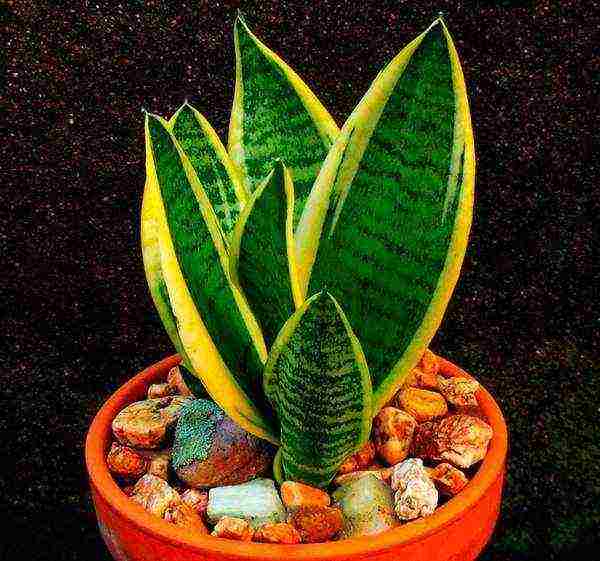

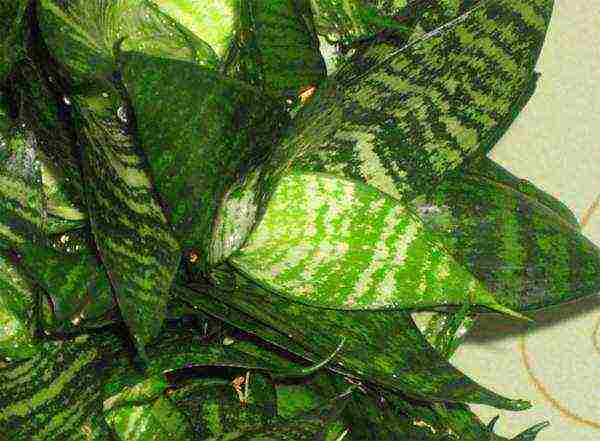
Reproduction
How to propagate mother-in-law's tongue at home? There are two main ways:
- leaf propagation;
- division of the rhizome.
Sheet
How does mother-in-law's tongue multiply with a leaf? It is not difficult, however, this method has a small disadvantage regarding varieties with variegated leaves. Young plants obtained from leaves will lose their pattern and will no longer be like the mother.
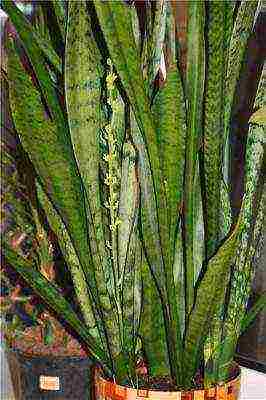 Fully mature and mature leaves are used to grow new plants. The leaf is cut (perpendicular to the veins) into several parts from 7 to 15 cm long.It is very important to remember where the upper and the lower side of the leaves are: if you plant the leaf with its upper side in the ground, it will take root can not.
Fully mature and mature leaves are used to grow new plants. The leaf is cut (perpendicular to the veins) into several parts from 7 to 15 cm long.It is very important to remember where the upper and the lower side of the leaves are: if you plant the leaf with its upper side in the ground, it will take root can not.
Cut cuttings are planted in the prepared soil not immediately. Sometimes individual pieces need to be allowed to dry. This happens for about 2-3 days. And only then can you start planting them for rooting.
It is better to use as a primer wet sand - this will help reduce the likelihood of cuttings rotting. They are placed in the ground by a third and covered with a jar or film.
Further planting in a permanent place is carried out only after rooting, after 1.5 - 2 months.
A photo of the reproduction of sansevieria by a leaf is presented below:
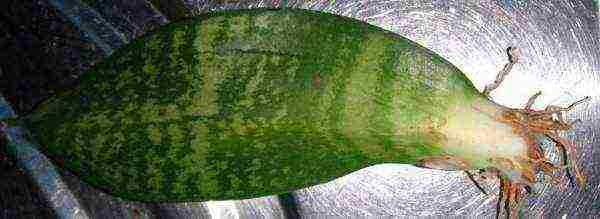
Vegetative way
Less labor intensive and more quick way obtaining young plants - flower reproduction by dividing the rhizome. In a vegetative way, sanseviers are propagated during transplantation.
To carry out division by this method, well-formed bushes are carefully removed from the pot and the rhizome is divided into several parts.
It is important to do this in such a way that each individual part has point of growth... Before planting each plant in its own pot, sprinkle the cut with charcoal.
If you did not even succeed in planting the flowers obtained as a result of dividing in pots, they can be placed in a jar of water. They can stand there for a long period of time, and this will not affect their condition.
Important nuances
The result of the work done on the reproduction of the sansevier directly depends on the observance of all the necessary conditions:
- Season. The most suitable season for obtaining new plants is a warm and sunny season - spring (April - May). Optimum temperature for germination, it must be at 20C. Due to this temperature, with leaf reproduction, young individuals will take root after 1 - 1.5 months. In the spring, a transplant is carried out, during which the division of the rhizome is carried out.
- Lighting. To adapt to new conditions, young plants must be kept in a well-lit, but at the same time protected from the sun's rays, place.
- Watering. When propagated by leaves of sansevieria, it is recommended to water through the pallet, during vegetative reproduction - moderate watering (in no case should the plants be flooded, in order to avoid decay).
Finally
The reproduction of sansevieria does not differ in special wisdom, and the subsequent care for them does not cause particular difficulty. Even novice florists will cope with all the intricacies of growing this indoor plant. And sansevieria will certainly answer with gratitude: it will decorate a living space or an office, and also - well to cleanse air.
Useful video
You can find out about the cultivation and reproduction of sansevieria in the following video:
Plant Care Memo
Young plants every 2, adults - every 4-5 yearsNormal room temperature is suitable, should not be lower than 8 and above 30In summer - once every 10 days, in winter - once every 2-3 weeksNot requiredDiffused light, partial shade possible
Lighting
 In its homeland, sansevieria grows in conditions of strong solar activity. However, for growth and development, it does not at all need to be in the sun.
In its homeland, sansevieria grows in conditions of strong solar activity. However, for growth and development, it does not at all need to be in the sun.
Mother-in-law's tongue feels great in diffused light and in partial shade.
Sansevieria is very unpretentious, but variegated varieties require more light and may even lose their color if it is lacking.
Direct sunlight does not harm sansevieria at all, therefore, if it is in the sun for several hours a day, no sunburn appears on the leathery leaves.
Loading …
Temperature
This plant can withstand a wide temperature range. It perfectly tolerates heat above 30 ° C, and in winter it can exist for a long time at temperatures of 8-10 ° C.
In winter, it is not necessary to lower the temperature for sansevieria.
Mother-in-law's tongue may be near heating radiators... Temperatures below 5 ° C and frosts, which leave frostbitten dead spots on the leaves, are fatal for him.
Watering
 Sansevieria stores a large amount of moisture in the rhizome, and hard leaves evaporate it very badly. Therefore, abundant watering for this plant is not needed and even harmful. It is adapted to water scarcity and drying out of the soil.
Sansevieria stores a large amount of moisture in the rhizome, and hard leaves evaporate it very badly. Therefore, abundant watering for this plant is not needed and even harmful. It is adapted to water scarcity and drying out of the soil.
Sansevieria is watered so that the clod of earth dries out at least 2/3... In summer, the flower needs to be well watered once every 10 days, and then dry the substrate in which it grows.
In winter, watering is reduced, watered once every 2-3 weeks, depending on the temperature in the room.Sansevieria is not demanding on the temperature and composition of water. However, do not water the plant with cold water.
The soil
 In nature, sansevieria grows on depleted stony soils of semi-deserts. But in an apartment environment, it is not at all necessary to plant it in an earthen mixture for succulents.
In nature, sansevieria grows on depleted stony soils of semi-deserts. But in an apartment environment, it is not at all necessary to plant it in an earthen mixture for succulents.
The plant is not subject to decay, therefore mother-in-law's tongue grows best in a universal soil mixture with the addition of baking powder: brick chips, perlite, fine gravel.
You can mix the substrate for planting sansevieria yourself. The most optimal composition: 4 parts of sod land, 1 part of sand, 2 parts of leaf land, 1 part of brick chips.
Fertilizer
This plant does not need frequent feeding. It is carried out only during the growing season from early May to September. It is enough to apply fertilizers once a month. In the autumn-winter period, feeding is stopped.
Sansevieria are suitable for special fertilizers for succulents... You can also use complex mineral fertilizers for decorative deciduous plants. In this case, the dosage must be halved.
Humidity
Existing in a steppe and semi-desert climate, the plant has adapted to very dry air. Therefore, it is not required to maintain a certain humidity in the room where sansevieria grows. In conditions of high humidity, the plant also feels good, although the risk of root rot increases.
Spraying sansevieria is not carried out... It does not need high humidity, and water entering the socket can lead to its rotting. To make the flower look beautiful and not dusty, it is enough to periodically wipe the leaves with a damp cloth.
Trim / Support / Garter
Pruning sansevieria is rarely required.
Special pruning of the plant is not carried out. It is only necessary to periodically prune the dying leaves to maintain the beautiful appearance of the plant and to remove very old rosettes with yellowed leaves.
But since the yellowing and drying of the leaves does not even happen every year, the pruning procedure is extremely rare.
Diseases
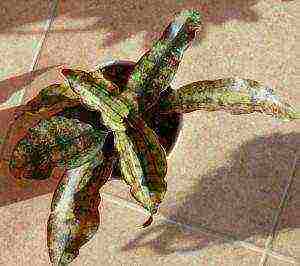 Sansevieria is a plant that is very resistant to various infectious and fungal diseases.
Sansevieria is a plant that is very resistant to various infectious and fungal diseases.
Sometimes, with a strong waterlogging of the soil, root rot develops, and when water enters the outlet, leaf decay.
To preserve the plant, it is enough to reduce watering, dry the soil, and remove the affected rosettes.
Pests very rarely settle on sansevieria.... Sometimes mealybugs or scale insects can be found, but pests do not multiply here in large numbers.
Therefore, they are often limited only to mechanical removal of harmful insects. If it is not possible to destroy the pests, you need to spray the plant with insecticidal preparations.
Problems
When growing sansevieria, even novice florists rarely have problems. But sometimes, due to significant mistakes in care, this flower may even die. It is necessary to regularly examine it and analyze the change in its appearance.
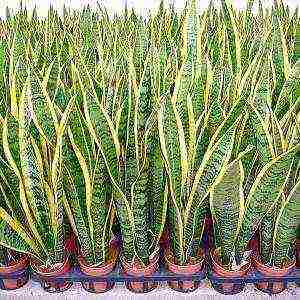 Most often, the plant suffers from over-watering. In this case, yellowing and dying off of the leaves occurs, they become soft. If you do not reduce watering, root decay may begin.
Most often, the plant suffers from over-watering. In this case, yellowing and dying off of the leaves occurs, they become soft. If you do not reduce watering, root decay may begin.
With a lack of moisture, if sansevieria is not watered for months, the leaves become lethargic and wrinkled.
With prolonged exposure to low temperatures, the growth of a flower is greatly slowed down, then its leaves wither and die off. In this case, if the temperature in the room is not increased, the plant may die.
In insufficient light, thin weak leaves grow, sansevieria stretches... Variegated varieties in the dark can lose light stripes or borders. With prolonged stay in a dark place, brown spots may appear on the leaves, especially when waterlogged.
Reproduction
In an apartment, sansevieria reproduces very easily in a vegetative way. For reproduction of sansevieria or mother-in-law's tongue, separate rosettes, parts of the rhizome and cut sheets are used.
The rosette separated from the plant and the rhizome fragments are planted directly in separate permanent pots. This procedure is carried out in the spring or summer during the growing season.
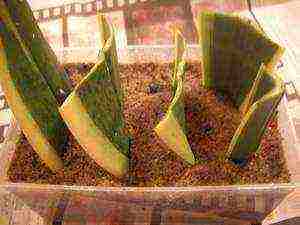 When dividing the rhizome, it is important that the planted part has at least one growth point. Further, with moderate watering of the shoots, they soon begin to grow and start up new shoots.
When dividing the rhizome, it is important that the planted part has at least one growth point. Further, with moderate watering of the shoots, they soon begin to grow and start up new shoots.
Sansevieria can be propagated with cut leaves... They are placed in water or immediately planted in the ground to a depth of 2-3 cm. In order to avoid leaf rot, they should be watered sparingly. After 1.5-2 months, they take root, and then form new shoots.
Now you know how to propagate mother-in-law's tongue at home.
Transfer
Young plants need to be transplanted once every 2 years. Adult flowers are rarely transplanted - once every 4-5 years, when the side shoots become cramped in the old pot. A transplant of sansevieria or mother-in-law's tongue is carried out in the spring or early summer.
The pot for the plant should be chosen wide and shallow, since it grows in width and does not have long roots. First, the flower is taken out of the pot and excess rosettes and shoots are cut off on the sides. The trimmed parts are planted in separate containers, and the old plant is transplanted into the old pot using the transfer method.
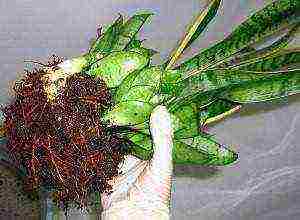 Before planting sansevieria, you need to pour a good drainage layer on the bottom of the pot. a few centimeters thick from expanded clay or shards. Then a layer of fresh soil is poured onto the bottom, the plant is placed in a pot and the rhizome is sprinkled with fresh earth.
Before planting sansevieria, you need to pour a good drainage layer on the bottom of the pot. a few centimeters thick from expanded clay or shards. Then a layer of fresh soil is poured onto the bottom, the plant is placed in a pot and the rhizome is sprinkled with fresh earth.
The plant should not be planted too deeply, and after transplanting it is useful not to water it for 2-3 days so that all root damage will heal.
Useful Tips
For amateur flower growers who grow sansevieria, you need to know a few useful tips, as well as medicinal properties of the plant:
- "Mother-in-law's tongue" grows very quickly, but when it reaches its maximum height, its growth stops;
- The plant contains useful biologically active substances, for example, saponins. After passing the necessary processing, they can be used in medicinal products;
- Tincture of their sansevieria can be used as an enema to eliminate intestinal problems;
- Sansevieria extract is used in the manufacture of choleretic, anti-inflammatory and laxative drugs. The juice of the leaves of the plant can be instilled into the ears for otitis media, the skin of the leaves has wound-healing properties, and a decoction from the plant helps with infections of the genitourinary system.
Plant toxicity and care and placement precautions
Although sansevieria is a beautiful plant and can be used for medicinal purposes, getting its juice inside can cause serious poisoning.
It's all about saponins - useful substances that, after special processing, are used in medicines. However, in large doses, they turn into poison.
 Signs of poisoning with sansevieria are: pain and burning in the throat, profuse salivation, vomiting and diarrhea.
Signs of poisoning with sansevieria are: pain and burning in the throat, profuse salivation, vomiting and diarrhea.
Cats and dogs that decide to nibble on the leaves of the Pike Tail will vomit, bowel upset, and dermatitis.
However, it is important to take into account that all these symptoms can appear only when the juice of the plant enters the body. Applied to the skin, the juice has wound healing properties.
Due to the fact that sansevieria is a poisonous plant, when placing and caring for it certain precautions should be taken:
- All manipulations with the flower, for example, transplanting or pruning, must be carried out with gloves and make sure that the juice does not get into the eyes;
- All trimmed parts of the plant must be immediately destroyed or thrown away;
- Sansevieria should not be placed in rooms where small children sleep or play;
- If there are cats or dogs in the house, it is better to put the plant out of their reach;
- At the first signs of poisoning with sansevieria juice, it is necessary to induce vomiting, then drink activated charcoal and seek medical help.
Description of the plant and species
Sansevieria is valued by flower growers for its rapid growth and original color of succulent leaves, amazing vitality and unpretentious care.
"Pike tail" is a member of the Agave family or, according to other sources, Asparagus. This perennial evergreen without a stem grows naturally in savannas, semi-deserts and deserts of Africa and Asia.
The plant is a succulent that stores water in tissues.... It has an underground creeping rhizome with powerful rhizomes. Erect, fleshy leaves grow upward from a powerful root. They are very dense, lanceolate, often waxy, and pointed at the ends.
There are varieties of sansevieria, in which the leaves reach a height of more than a meter. Other species have small rosettes growing more in breadth than in height. Depending on the variety and species, the leaves can be colored in different shades of green or brown, on their surface there may be horizontal or vertical stripes, or a bright edging.
The "mother-in-law's tongue" blooms in early spring - the rosette produces a long peduncle, on which small white flowers are collected in a spike-shaped inflorescence, exuding a pleasant vanilla aroma.
Sansevieria bloom lasts 2 weeks.
The most common types for indoor floriculture are:
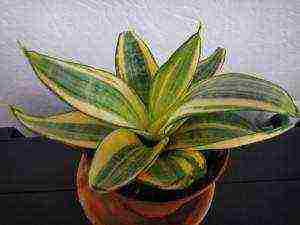 Sansevieria three-lane - has long xiphoid leaves, reaching 1 meter in length. They are bright green in color with darker transverse stripes. A yellow-white border may be present.
Sansevieria three-lane - has long xiphoid leaves, reaching 1 meter in length. They are bright green in color with darker transverse stripes. A yellow-white border may be present.- Sansevieria Hanni is a dwarf species, up to 30 cm high. Dark green leaves with various light stripes or blotches form a rosette. It has several subspecies with different leaf colors.
- Sansevieria large - has wide fleshy leaves, 30-60 cm high, up to 15 cm wide. Their color is light green with dark transverse stripes and a reddish border.
- Sansevieria cylindrical - has dark green cylindrical leaves, 1.5-2 cm in diameter, with silvery transverse stripes. There is a deep groove along the leaf.
Now you know everything about caring for an indoor flower sansevieria or mother-in-law's tongue at home.


